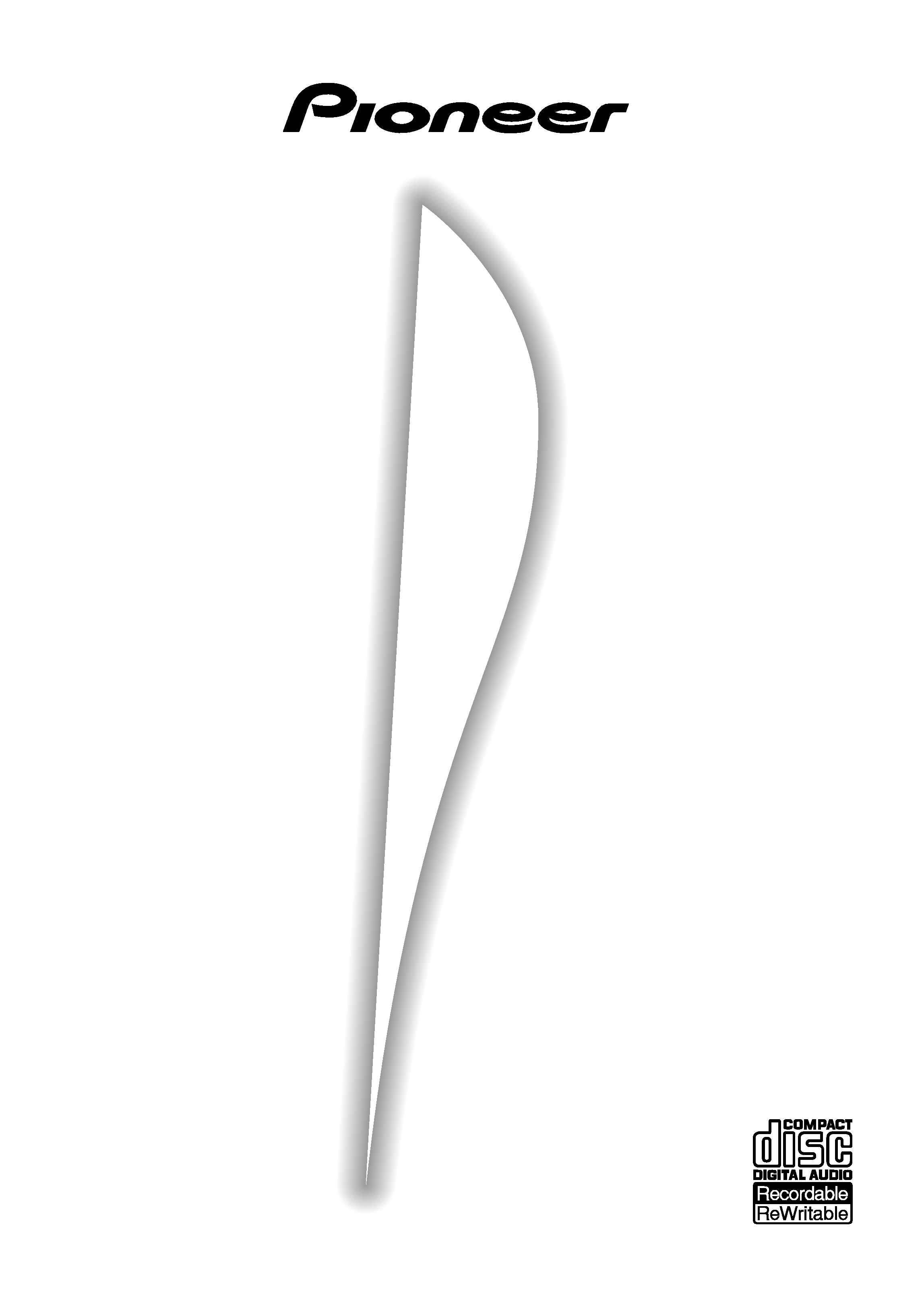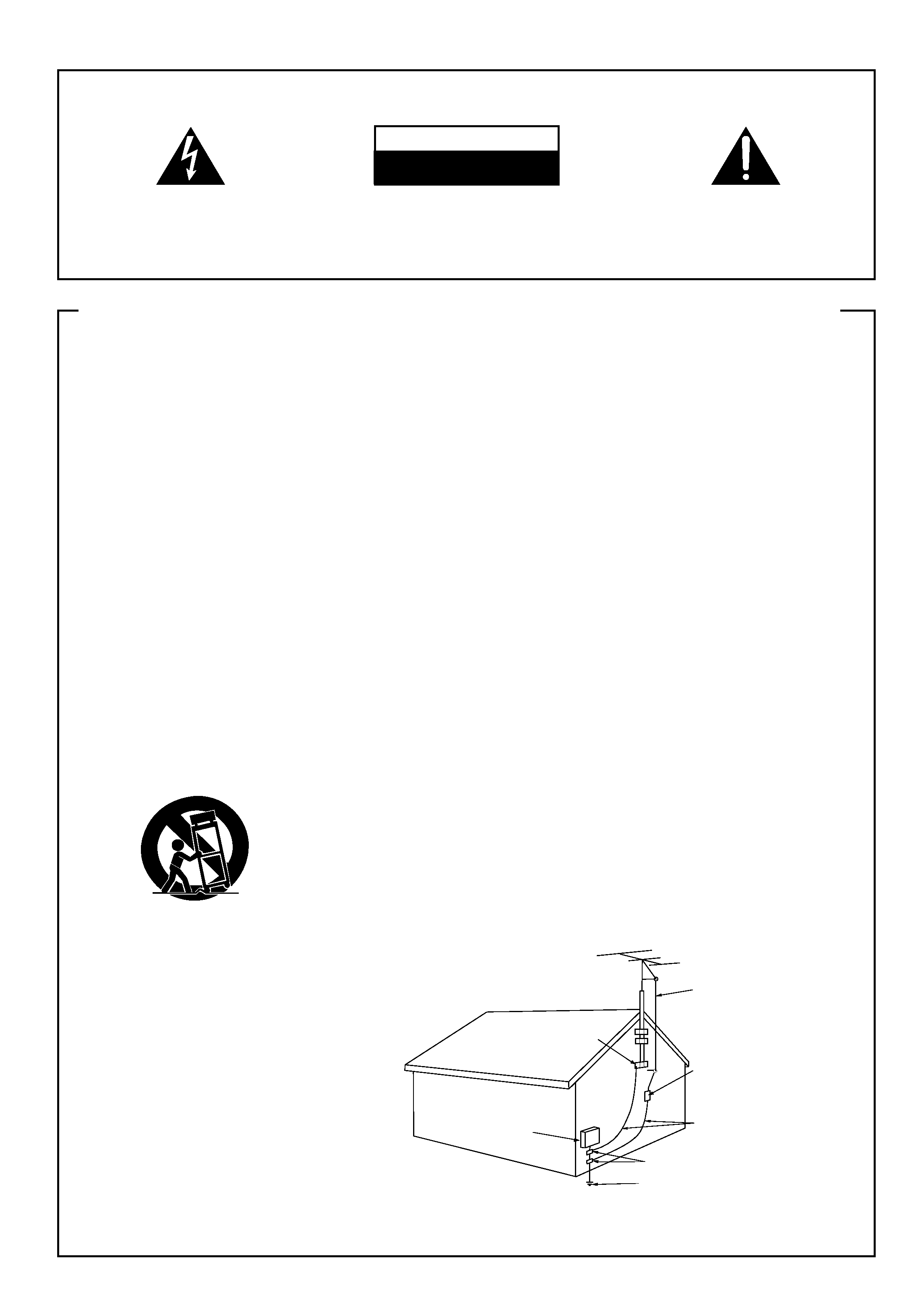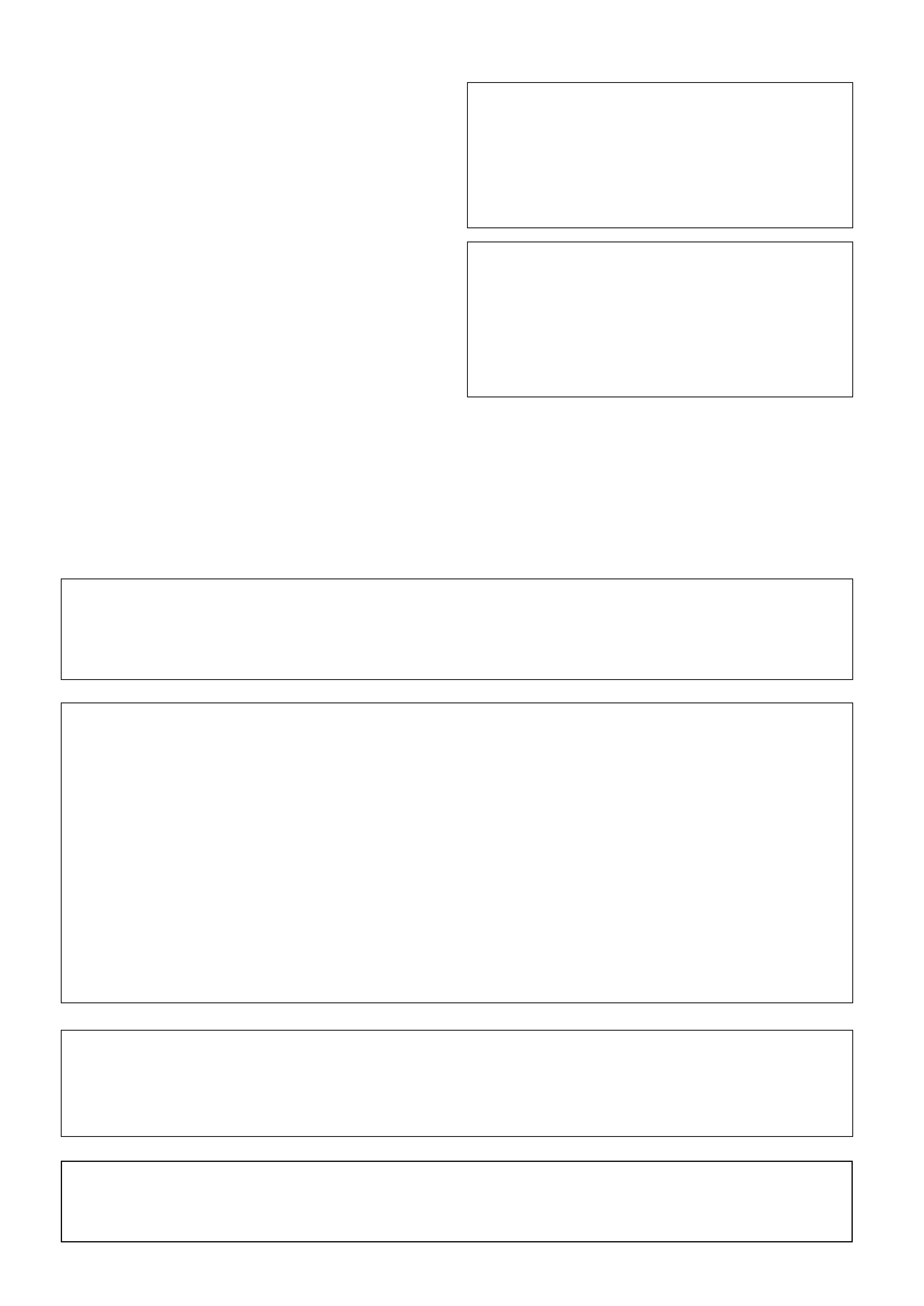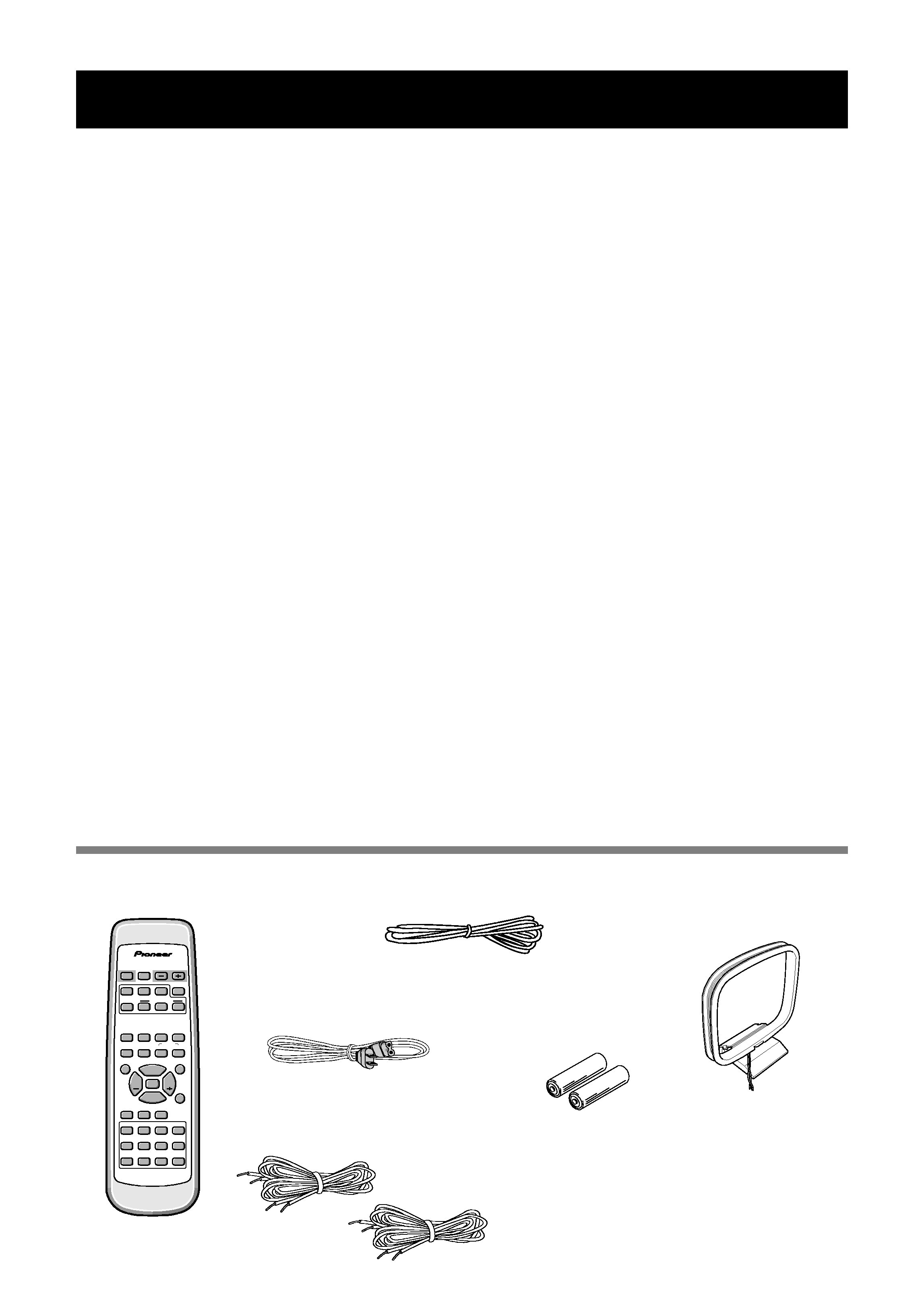
Operating Instructions
STEREO CD/CD-R RECEIVER
XR-MR7

The exclamation point within an equilateral
triangle is intended to alert the user to the presence
of important operating and maintenance
(servicing) instructions in the literature
accompanying the appliance.
IMPORTANT
The lightning flash with arrowhead symbol, within
an equilateral triangle, is intended to alert the
user to the presence of uninsulated "dangerous
voltage" within the product's enclosure that may
be of sufficient magnitude to constitute a risk of
electric shock to persons.
CAUTION:
TO PREVENT THE RISK OF ELECTRIC SHOCK, DO
NOT REMOVE COVER (OR BACK). NO USER-SER-
VICEABLE PARTS INSIDE. REFER SERVICING TO
QUALIFIED SERVICE PERSONNEL.
RISK OF ELECTRIC SHOCK
DO NOT OPEN
CAUTION
READ INSTRUCTIONS -- All the safety and operating
instructions should be read before the product is
operated.
RETAIN INSTRUCTIONS -- The safety and operating
instructions should be retained for future reference.
HEED WARNINGS -- All warnings on the product and
in the operating instructions should be adhered to.
FOLLOW INSTRUCTIONS -- All operating and use
instructions should be followed.
CLEANING -- Unplug this product from the wall outlet
before cleaning. The product should be cleaned only
with a polishing cloth or a soft dry cloth. Never clean
with furniture wax, benzine, insecticides or other
volatile liquids since they may corrode the cabinet.
ATTACHMENTS -- Do not use attachments not
recommended by the product manufacturer as they
may cause hazards.
WATER AND MOISTURE -- Do not use this product
near water -- for example, near a bathtub, wash
bowl, kitchen sink, or laundry tub; in a wet basement;
or near a swimming pool; and the like.
ACCESSORIES -- Do not place this product on an
unstable cart, stand, tripod, bracket, or table. The
product may fall, causing serious injury to a child or
adult, and serious damage to the product. Use only
with a cart, stand, tripod, bracket, or table
recommended by the manufacturer, or sold with
the product. Any mounting of the product should
follow the manufacturer's instructions, and should
use a mounting accessory recommended by the
manufacturer.
CART -- A product and cart combination should be
moved with care. Quick stops, excessive force, and
uneven surfaces may cause the product and cart
combination to overturn.
GROUNDING OR POLARIZATION
¶ Ifthisproductisequippedwithapolarizedalternating
current line plug (a plug having one blade wider than
the other), it will fit into the outlet only one way. This
is a safety feature. If you are unable to insert the plug
fully into the outlet, try reversing the plug. If the plug
should still fail to fit, contact your electrician to
replace your obsolete outlet. Do not defeat the
safety purpose of the polarized plug.
¶ If this product is equipped with a three-wire
grounding type plug, a plug having a third (grounding)
pin, it will only fit into a grounding type power outlet.
This is a safety feature. If you are unable to insert the
plug into the outlet, contact your electrician to
replace your obsolete outlet. Do not defeat the
safety purpose of the grounding type plug.
POWER-CORD PROTECTION -- Power-supply cords
should be routed so that they are not likely to be
walked on or pinched by items placed upon or
against them, paying particular attention to cords at
plugs, convenience receptacles, and the point where
they exit from the product.
OUTDOOR ANTENNA GROUNDING -- If an outside
antenna or cable system is connected to the product,
be sure the antenna or cable system is grounded so
as to provide some protection against voltage surges
and built-up static charges. Article 810 of the National
Electrical Code, ANSI/NFPA 70, provides information
with regard to proper grounding of the mast and
supporting structure, grounding of the lead-in wire
to an antenna discharge unit, size of grounding
conductors, location of antenna-discharge unit,
connection to grounding electrodes, and
requirements for the grounding electrode.
See Figure A.
LIGHTNING -- For added protection for this product
during a lightning storm, or when it is left unattended
and unused for long periods of time, unplug it from
the wall outlet and disconnect the antenna or cable
system. This will prevent damage to the product
due to lightning and power-line surges.
POWER LINES -- An outside antenna system should
not be located in the vicinity of overhead power lines
or other electric light or power circuits, or where it
can fall into such power lines or circuits. When
installing an outside antenna system, extreme care
should be taken to keep from touching such power
lines or circuits as contact with them might be fatal.
OVERLOADING -- Do not overload wall outlets,
extension cords, or integral convenience receptacles
as this can result in a risk of fire or electric shock.
OBJECT AND LIQUID ENTRY -- Never push objects of
any kind into this product through openings as they
may touch dangerous voltage points or short-out
parts that could result in a fire or electric shock.
Never spill liquid of any kind on the product.
SERVICING -- Do not attempt to service this product
yourself as opening or removing covers may expose
you to dangerous voltage or other hazards. Refer all
servicing to qualified service personnel.
DAMAGE REQUIRING SERVICE -- Unplug this product
from the wall outlet and refer servicing to qualified
service personnel under the following conditions:
¶ When the power-supply cord or plug is damaged.
¶ If liquid has been spilled, or objects have fallen into
the product.
¶ If the product has been exposed to rain or water.
¶ If the product does not operate normally by following
the operating instructions. Adjust only those controls
that are covered by the operating instructions as an
improper adjustment of other controls may result in
damage and will often require extensive work by a
qualified technician to restore the product to its
normal operation.
¶ If the product has been dropped or damaged in any
way.
¶ When the product exhibits a distinct change in
performance -- this indicates a need for service.
REPLACEMENT PARTS -- When replacement parts
are required, be sure the service technician has used
replacement parts specified by the manufacturer or
have the same characteristics as the original part.
Unauthorized substitutions may result in fire, electric
shock, or other hazards.
SAFETY CHECK -- Upon completion of any service or
repairs to this product, ask the service technician to
perform safety checks to determine that the product
is in proper operating condition.
WALL OR CEILING MOUNTING -- The product should
not be mounted to a wall or ceiling.
HEAT -- The product should be situated away from heat
sources such as radiators, heat registers, stoves, or
other products (including amplifiers) that produce
heat.
IMPORTANT SAFETY INSTRUCTIONS
GROUND
CLAMP
ANTENNA
DISCHARGE UNIT
(NEC SECTION 810-20)
GROUNDING CONDUCTORS
(NEC SECTION 810-21)
GROUND CLAMPS
POWER SERVICE GROUNDING
ELECTRODE SYSTEM
(NEC ART 250, PART H)
ELECTRIC
SERVICE
EQUIPMENT
Fig. A
ANTENNA
LEAD IN
WIRE
NEC -- NATIONAL ELECTRICAL CODE
VENTILATION -- Slots and openings in the cabinet are
provided for ventilation and to ensure reliable
operation of the product and to protect it from
overheating, and these openings must not be
blocked or covered. The openings should never be
blocked by placing the product on a bed, sofa, rug,
or other similar surface. This product should not be
placed in a built-in installation such as a bookcase or
rack unless proper ventilation is provided or the
manufacturer's instructions have been adhered to.
POWER SOURCES -- This product should be operated
only from the type of power source indicated on the
marking label. If you are not sure of the type of
power supply to your home, consult your product
dealer or local power company.
LOCATION The appliance should be installed in a
stable location.
NONUSE PERIODS The power cord of the appliance
should be unplugged from the outlet when left un-
used for a long period of time.

[For Canadian model]
This Class B digital apparatus complies with
Canadian ICES-003.
[Pour le modèle Canadien]
Cet appareil numérique de la classe B est
conforme à la norme NMB-003 du Canada.
CAUTION:
¶ Use of controls or adjustments or performance of procedures other than those specified herein hazardous radiation
exposure.
¶ The use of optical instruments with this product will increase eye hazard.
This equipment has been tested and found to comply with the limits for a Class B digital device,
pursuant to Part 15 of the FCC Rules. These limits are designed to provide reasonable protection
against harmful interference in a residential installation. This equipment generates, uses, and can
radiate radio frequency energy and, if not installed and used in accordance with the instructions,
may cause harmful interference to radio communications. However, there is no guarantee that
interference will not occur in a particular installation. If this equipment does cause harmful interference
to radio or television reception, which can be determined by turning the equipment off and on, the
user is encouraged to try to correct the interference by one or more of the following measures:
Reorient or relocate the receiving antenna.
Increase the separation between the equipment and receiver.
Connect the equipment into an outlet on a circuit different from that to which the receiver is
connected.
Consult the dealer or an experienced radio/TV technician for help.
CAUTION:
This product satisfies FCC regulations when shielded cables and connectors are used to connect the
unit to other equipment. To prevent electromagnetic interference with electric appliances such as radios
and televisions, use shielded cables and connectors for connections.
WARNING: TO PREVENT FIRE OR SHOCK
HAZARD, DO NOT EXPOSE THIS APPLIANCE TO RAIN
OR MOISTURE.
IMPORTANT NOTICE
The serial number for this equipment is located in the
rear. Please write this serial number on your enclosed
warranty card and keep it in a secure area. This is for
your security.
Information to User
Alteration or modifications carried out without appropriate authorization may invalidate the user's right to operate
the equipment.
[For U.S. model]
DANGER LASER RADIATION WHEN
OPEN.
AVOID DIRECT EXPOSURE TO BEAM.
This caution can be found on the rear panel of
the unit.
[For Canadian model]
CAUTION: TO PREVENT ELECTRIC SHOCK DO NOT
USE THIS (POLARIZED) PLUG WITH AN EXTENSION
CORD, RECEPTACLE OR OTHER OUTLET UNLESS THE
BLADES CAN BE FULLY INSERTED TO PREVENT BLADE
EXPOSURE
ATTENTION: POUR PREVENIR LES CHOCS
ELECTRIQUES NE PAS UTILISER CETTE FICHE POLARISEE
AVEC UN PROLONGATEUR, UNE PRISE DE COURANT OU
UNE AUTRE SORTIE DE COURANT, SAUF SI LES LAMES
PEUVENT ETRE INSERESS A FOND SANS EN LAISSER
AUCUNE PARTIE A DECOUVERT.

4
Features
Please check to see you have received the included accessories
¶ Remote control unit : 1
¶ FM antena : 1
¶ AM loop antenna (shown
assembled) : 1
¶ Size AA/R6P dry
cell batteries : 2
1.
Record and playback CD-R and CD-RW discs
Both CD-R and CD-RW type recordable discs can be recorded. CD-RW discs can be erased and
re-used; CD-R discs are 'record-once' and cannot be erased. CD-R and CD-RW discs both give
the same high-quality sound that you get from commercially-produced CDs.
In addition, once a CD-R has been finalized (a Table Of Contents is recorded) it becomes a
standard CD, playable on any ordinary CD player.*
2.
3 CD Changer for Extended Playback
Three compact discs can be loaded to provide extended, continuous playback or select playback
from any of the three. An addition, two of the discs can be changed while the remaining disc is
playing.
3.
Sampling rate converter
When recording from digital sources such as DAT, DCC and DVD 32kHz or 48kHz only, this unit
automatically converts the sample rate to the CD-standard 44.1kHz.
However, during recording, the digital source is output from this system's digital out at its original
sampling frequency.
4.
Digital synchro recording mode
When making digital recordings from CD, DAT, MD, DCC, etc. this system can synchronize with
the source component, starting and stopping automatically. You can also make compilation CDs
very easily using the 1-track synchro recording feature.
5.
Low power consumption
This system uses less than 0.6W when in standby mode.
* If the CD player's pickup lens is slightly dirty, you may find that it will play commercially-produced CDs, but
not finalized CD-Rs.
¶ Warranty card
¶ Operating instructions
STANDBY
/ON
SLEEP
CD SELECT
PLAY MODE DISPLAY
SFC
ENTER
MENU
/NO
ST.
ST.
P.BASS
CLEAR
SET
SKIP ID
REC MENU
`
7
1¡
4¢
6
PGM
RANDOM REPEAT
REMOTE CONTROL UNIT
FINALIZE
VOLUME
TAPE
CDR
LINE
1
1
23
234
5
678
9
10/0
>10
CLR
FM/AM
MONO
¶ Speaker cables : 2
¶ AC Power cord : 1
~Also included~

5
PREPARATION
Contents
FM/AM
RADIO
3
CD
CHANGER
CD-R/CD-RW
TIMER
OTHERS
PREPARATION
Features ................................................ 4
Contents ................................................ 5
Connections .......................................... 6
Controls & Display ............................... 11
Setting the Clock ................................. 15
FM/AM RADIO
Using the FM/AM Radio ...................... 16
Tuning Directly to a Station ................. 17
3 CD CHANGER
Listening to the 3 CD CHANGER ....... 19
Choosing a Play Mode ........................ 21
Programing the Track Oder ................. 22
Using Random Play ............................ 24
Using Repeat Play .............................. 24
About the CD CHANGER Display ....... 25
CD-R/CD-RW
Listening to the CD Recorder .............. 26
Programing the Track Oder ................. 28
Using Random Play ............................ 30
Using Repeat Play .............................. 30
About CD, CD-R and CD-RW Discs .... 31
Points to Remember
when Recording .................................. 33
Quick Copying ..................................... 34
Recording Automatically
Using the Menu Functions .................. 35
Switching between
Analog and Digital Recording ............. 37
Making a Digital Synchro Recording ... 38
Making a Digital Recording Manually .. 43
Setting the Digital Recording Levels ... 44
Analog Recording ............................... 45
Numbering Tracks ............................... 47
About SCMS ....................................... 48
Setting and Clearing Skip IDs ............. 49
About the CD Recorder Display .......... 51
Finalizing a Disc .................................. 52
Erasing a CD-RW Disc ........................ 53
TIMER
Sleep Timer ......................................... 56
Wakeup Timer Operation .................... 57
Unattended Recording ........................ 59
OTHERS
Changing the Tone .............................. 61
Changing the Brightness ..................... 61
Changing the Information Display ....... 62
Setting the Input for a Turntable .......... 62
Using the Attenuator ........................... 63
Understanding Display Messages ....... 64
Troubleshooting ................................... 65
Specifications ...................................... 67
